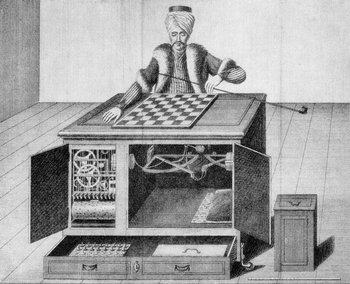“The Turk”
In 1770, around the start of the industrial revolution, Wolfgang von Kempelen of Vienna created a chess playing automaton which came to be known as the Turk. The name came from the machine’s appearance: a life-sized, wooden figure wearing a turban and robe. During the late 18th and early 19th centuries the Turk toured Europe and America, amazing audiences and defeating almost everyone whom it played.
The Turk was in fact a hoax. A man concealed inside the base operated the machine. Despite the fact that the machine was not a true robot, roboticists today remember it as a forerunner of modern robotics.

Project Description
TeRK, which stands for Telepresence Robot Kit, is a project of the Mobile Robot Programming Lab at Carnegie Mellon University’s Robotics Institute. As a part of the Toy Robots Initiative, TeRK aims to make educational robotics fun, affordable, and accessible to a diverse community of college students, pre-college students, and all individuals interested in robotics. TeRK builds upon the success of our previous project, the Personal Rover Project.
Background and motivation
Between 2001 and 2005 the Personal Rover Project designed robots, processor boards and educational curriculum for the real world. We have taken these products to both formal learning venues, from middle school to college, and informal learning centers, including the Smithsonian Air & Space Museum, the San Francisco Exploratorium and the Japan World Expo. Over 200,000 children and adults have interacted directly with our robots, and formal educational evaluations of the resulting learning, conducted by University of Pittsburgh’s UPCLOSE/LRDC, have yielded statistically significant results in the area of gender retention, identification with technology, and lifelong-learning skills acquisition:
- Girls entered coursework with lower confidence with technology, but we not discouraged and in fact gained confidence more quickly than boys, even in the context of robot programming challenges.
- Significant gains in teamwork, problem-solving, identification with technology and specifics of mechanism and computation—all key STEM issues.
- In museum samples, 71% of girls and 61% of boys at the exhibit engaged with collaborative robot exploration.
- In museum samples, 98% of users continued using the robot for several minutes, conducting a complete robotic exploration.
Our results to date have demonstrated that robotics is up to the task of playing a pivotal role in curriculum: robot reliability and richness of interaction has reached an important breakaway point in the curve of this relatively recent technology. Our results have also demonstrated that robots serve as a compelling tool for education both at college and pre-college levels, bolstering critical gender retention chances and facilitating lifelong learning. Given the timely discussion of STEM gaps and technology illiteracy today, the effective role of robots in education offers an encouraging sign of hope in stemming today’s trends.
Consider the most recent wave of technology breakthroughs: high-speed ARM microprocessor technology at never before seen price points; ARM-FPGA proofs-of-concept for robot control demonstrated in the national BotBall contest; USB Camera functionality / price points and custom board and chassis prototyping facilities now available.
We know robotics is an educational home run, and these technological advancements mean that today’s technological leading edge, if used to design new robot kits, new robot processor boards and new infrastructure for robot connectivity, can lead to the introduction of educational robots with more capability and a lower price than we have seen in the community before.
We intend to create the new class of robot and processor board that can trigger a small revolution in the role of educational robotics, and we intend to facilitate the birth of a community of users that will give educational robotics a healthy and rapidly growing life of its own.
Research Plan
In order for the TeRK project to be a success we will need to conduct research and development in multiple areas. We have identified the following six major research thrusts:
- Robot Reference Design Library
- Robot Embedded Electronics Package
- Robot Connectivity and Development Software
- Community Curriculum Design Effort
- Pilot Education and Evaluation Rollout
- Web-based Community Dissemination